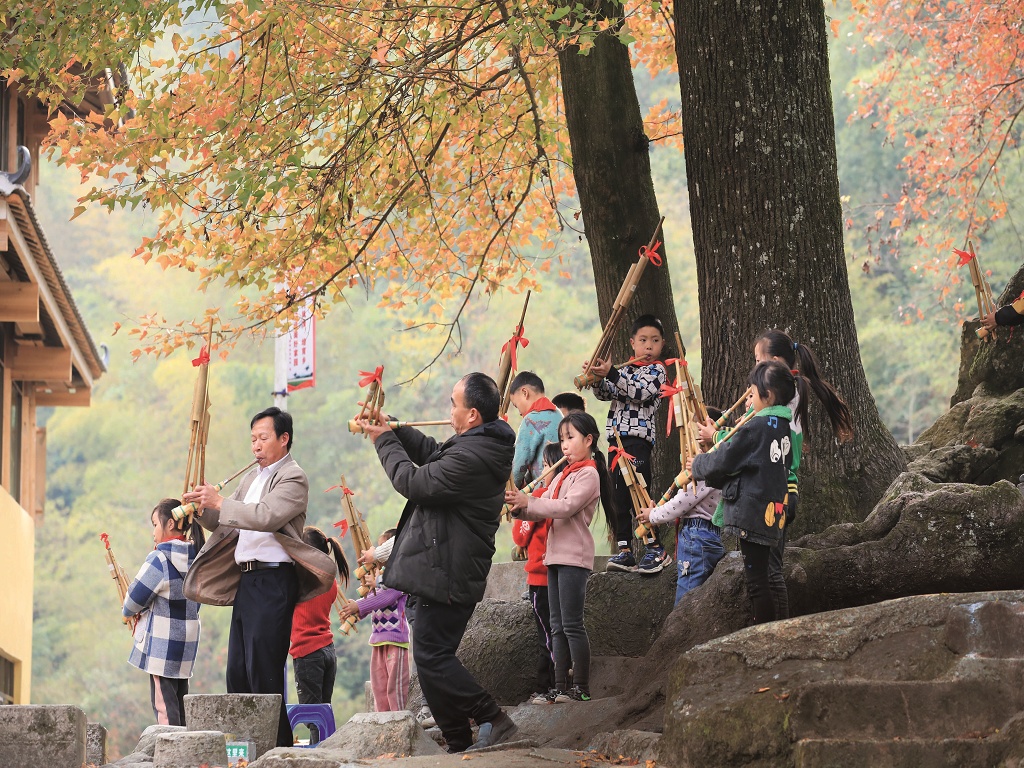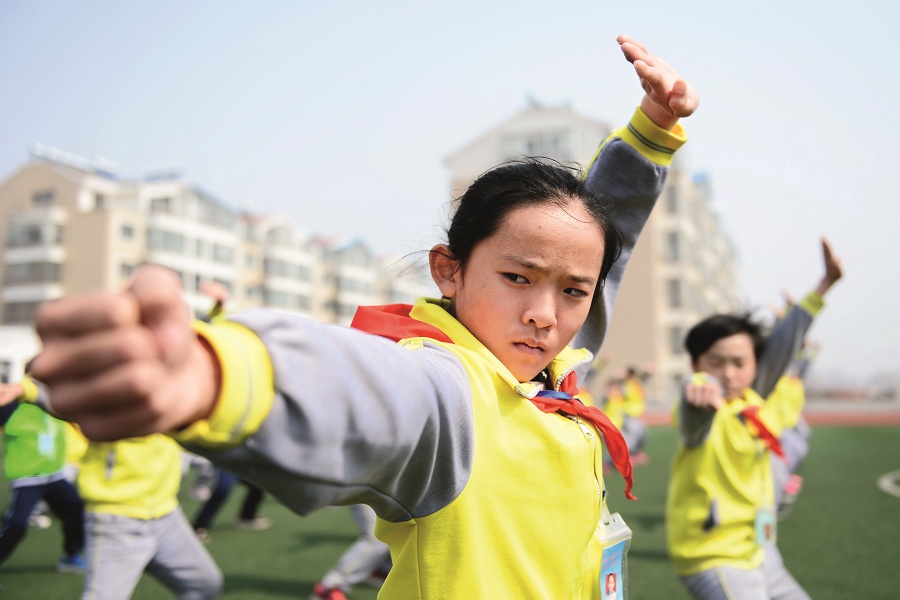Intangible Cultural Heritage: Thriving on Campus and Beyond

Schools present fertile ground for inheritance of intangible cultural heritage. In recent years, intangible cultural heritage has gained ground on China’s campuses while cultivating numerous students to master relevant skills.
Students in primary and secondary schools are often introduced to the charm of intangible cultural heritage after participating in theme activities. Vocational schools cultivate skilled personnel to inherit intangible cultural heritage while innovating ethnic culture as part of national demonstration practices. University students can now earn undergraduate, master’s, and doctoral degrees related to intangible cultural heritage, which is lifting talent cultivation to a new historic stage of high-level specialization.
The on-campus vibe of intangible cultural heritage is sowing the seeds of cultural inheritance to empower people to pass on fine traditional culture from generation to generation.
Touching Enlightenment
Every morning, students at the No. 1 and No. 4 primary schools in Qiaotou Township, Dongguan City, Guangdong Province, engage in traditional boxing exercises attentively, with a series of actions from squaring away steadily to moving forward, turning sideways, stamping feet, and shouting loudly, under the instruction of PE teachers. At the No. 2 Primary School in Xingqing District, Yinchuan City, Ningxia Hui Autonomous Region, students sew palm-sized fish toys with tie-dyed cloth at an on-campus workshop. The workshop’s walls and booths are decorated with students’ tie-dye and batik works as well as displays of fans, pillows, and hats they sewed.
In recent years, primary and secondary schools nationwide have been actively introducing intangible cultural heritage into campuses under the guidance of China’s Ministry of Education. Many inheritors of intangible cultural heritage have delivered lectures and demonstrated their skills on campus. Special primary and secondary schools have been established successively to cultivate “student envoys” of intangible cultural heritage such as Chinese opera, calligraphy, seal cutting, and ethnic and folk fine arts.
Concurrently, implementation of the “double reduction” policy has helped many schools incorporate items of intangible cultural heritage into after-school services to enrich children’s learning.

Primary school students perform martial arts on a playground in Rongcheng City, Shandong Province, March 25, 2019. (Photo from CNS)
Learning Techniques
Named after an ancient guild of craftsmen whose works decorated the Potala Palace and other temples and palaces in southwestern China’s Tibet Autonomous Region, the Xueduibai School for Traditional Arts and Crafts is located in the northern suburb of Lhasa. The endless clanging from the small courtyard of the school indicates that students are learning metalworking techniques. Students can also learn how to draw thangka (a richly colored form of classical Tibetan painting), sew Tibetan costumes, and apply Tibetan block printing skills.
Song Ming, founder and principal of the school, is a native of Xuzhou City, Jiangsu Province, and a graduate of the Department of Oil Painting at the Nanjing University of the Arts. In the 1990s, Song joined the second batch of assistance personnel from Jiangsu to work in Tibet. While working as an art teacher in Lhasa, Song spent much of his time on field trips to compile the book Collection of Tibetan Handicrafts. He discovered that many local intangible cultural heritage items had either failed to be handed down or were teetering on the verge of extinction. He decided to promote inheritance of Tibetan intangible cultural heritage via education while combining his academic background and advanced concepts learned in Jiangsu Province.

A student (left) from the intermediate thangka class at the Xueduibai School for Traditional Arts and Crafts shares the progress of his graduation work with his teacher, 2016. (Photo by Yeshe Tenzin)
“I founded the school in 2010 with savings I had earned from a culture-oriented company and the teaching network I established to mainly serve students from Tibet’s farming and pastoral areas for free,” Song talked of the origin of the school, emphasizing that the institution has been sponsoring teaching, research and development, incubation projects and docking with the market since its founding. The school provides courses including thangka painting, ceramic production, cloth weaving, and more. Its teaching staff include teachers from local universities, intangible cultural heritage inheritors, and folk artists. The curricula involve cultural theories, handicraft skills and compulsory vocational courses stipulated by the state. “The curricula empower students to both master the crafts and develop understanding of traditional ethnic culture behind them,” Song explained.
Since its establishment, some 500 students majoring in intangible cultural heritage have graduated from the Xueduibai School for Traditional Arts and Crafts. “Many continue to engage in handicraft work after graduation,” Song said. “Some have set up their own studios with the help of the incubation projects launched by the school.”
“Some early graduates have already climbed to the top of their respective industries and made important contributions to the inheritance and development of Tibetan handicrafts,” he added.
The school plans to offer the stone carving course in the future. “After that, the school’s curricula will basically cover every existing Tibetan intangible cultural heritage item,” Song noted. He hopes to build it into Tibet’s first private art college or university, a goal for which all the faculty has been striving.

Metalworking students at the Xueduibai School for Traditional Arts and Crafts focus on their school work, 2017. (Photo by Norbu Dondrup)
Cultivating Talent
Chen Yang is a postgraduate student majoring in ceramic decoration and painting at Jingdezhen Ceramic University. He is versed in a long list of processes including casting, hand-painting, glazing, and firing to transform clay into blue-and-white porcelain with different features.
So far, more than 70,000 students have graduated from Jingdezhen Ceramic University. Among them, many are now masters of ceramics and other crafts. Also, graduates of the multi-disciplinary institution, the only one named after ceramics in China, have contributed 80 percent of the country’s architectural ceramics and daily-use ceramics brands. The university is thus acclaimed as the “Cradle of China’s Ceramics Industry.”
Its curricula are divided into two categories: inheritance and innovation, with focus on the research of cutting-edge ceramic technologies such as heat-resistant ceramics. The university provides great support for upgrading China’s ceramic industry through scientific and technological progress. Its complete higher education system ranging from undergraduate to master’s and doctoral programs has cultivated students both theoretically and practically. The students get many chances to discuss ceramic crafts with like-minded teachers and friends on campus and go on field trips to ceramics bases, ceramics enterprises, and kiln factories while wandering around Jingdezhen, a living ceramics museum.

Associate Professor Yuan Lehui demonstrates casting skills for students of the 2010 pottery class at Jingdezhen Ceramic University, April 2012. (Photo courtesy of Jingdezhen Ceramic University)
And cultural exchange also happens there.
“Archaeologists from all over the world yearn for the opportunity to learn about the porcelain-making history in Jingdezhen, the capital of Chinese porcelain,” smiled Mahdi Ahmad, an overseas student from Egypt.
After graduating from the Faculty of Archaeology of Fayuom University in 2020, Ahmad arrived at Jingdezhen Ceramic University to study the inscriptions on ancient Chinese porcelain wares. He hopes to review the millennia-old Silk Road bond between China and Arabic countries by researching Arabic characters on ancient porcelain. During his studies in China, Ahmad visited many archaeological sites, museums, and ancient buildings to explore the past.
In total, the university has attracted more than 3,000 international students from over 60 countries and regions worldwide and empowered them to deploy a poetic science with a “great perhaps.”

Students show the porcelain wares they painted with blue-and-white patterns in a ceramics training course targeting South African students at Jingdezhen Ceramic University, September 2017. (Photo courtesy of Jingdezhen Ceramic University)